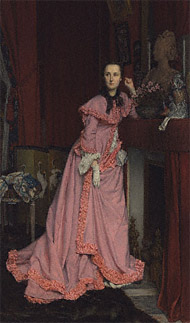 |
 |
 |
 |
Grades/Level: High School (9–12)
Subjects: Visual Arts, English–Language Arts, History–Social Science
Time Required: 3–5–Part Lesson
Four class periods
Author: J. Paul Getty Museum Education Staff
Permissions: 
The lesson plan and downloadable materials on this page are licensed under a Creative Commons Attribution 4.0 International License. |
 |
|
 |
 |
 |
 |
 |
 |
 |
Lesson Overview |
 |
Students will analyze how a portrait reflects the events and trends of its time and then create a portrait of a public female figure today. |
 |
 |
 |
 |
 |
Learning Objectives |
 |
Students will be able to:
• research the effects of European expansionism and colonialism on different groups of people during the Age of Exploration;
• discuss the notion of "exoticism" as it relates to a 19th-century painting, the burgeoning of stereotypes, and modern-day stereotyping in the media;
• create a portrait of a female public figure from a different culture. |
 |
 |
 |
 |
 |
 |
 |
 |
 |
Materials |
 |
• Reproduction of Portrait of the Marquise de Miramon, née Thérèse Feuillant by Jacques Joseph Tissot
• Background Information and Questions for Teaching about the painting (click on the thumbnail of the painting below)
• Drawing paper
• Oil pastels |
 |
 |
 |
 |
 |
|
|
 |
 |
 |
 |
 |
Lesson Steps |
 |
Download the complete lesson by clicking on the "download this lesson" icon above.
Additional Resource:
Learn more about and compare two 19th-century paintings portraying women: Portrait of the Marquise de Miramon, née, Thérèse Feuillant by Jacques Joseph Tissot and The Milliners by Edgar Germain Hilaire Degas.
Glossary Terms:
Words in bold on these pages and in the lesson are defined in the glossary for this curriculum (see "For the Classroom" links above).
|
 |
 |
 |
| Portrait of the Marquise de Miramon, née Thérèse Feuillant, Jacques Joseph Tissot, 1866 |
 |
|
 |
 |
 |
 |
 |
 |
 |
Standards Addressed |
 |
Common Core Standards for English Language Arts
Grades 9–12
WRITING
Research to Build and Present Knowledge
7. Conduct short as well as more sustained research projects based on focused questions, demonstrating understanding of the subject under investigation.
8. Gather relevant information from multiple print and digital sources, assess the credibility and accuracy of each source, and integrate the information while avoiding plagiarism.
9. Draw evidence from literary or informational texts to support analysis, reflection, and research.
SPEAKING AND LISTENING
Comprehension and Collaboration
1. Prepare for and participate effectively in a range of conversations and collaborations with diverse partners, building on others' ideas and expressing their own clearly and persuasively.
2. Integrate and evaluate information presented in diverse media and formats, including visually, quantitatively, and orally.
For more national and California state standards for this curriculum, refer to the charts found in the links at the top right of this page. |
 |

|
 |
 |
 |



